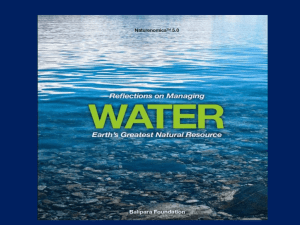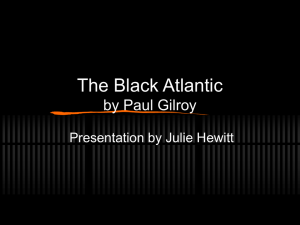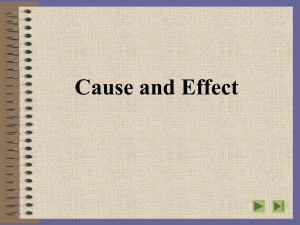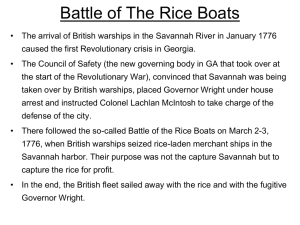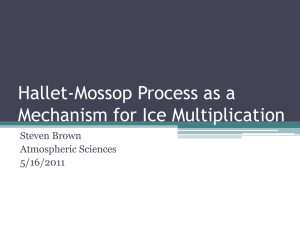The 8.2 ka Event - PSU Glacier Research
advertisement
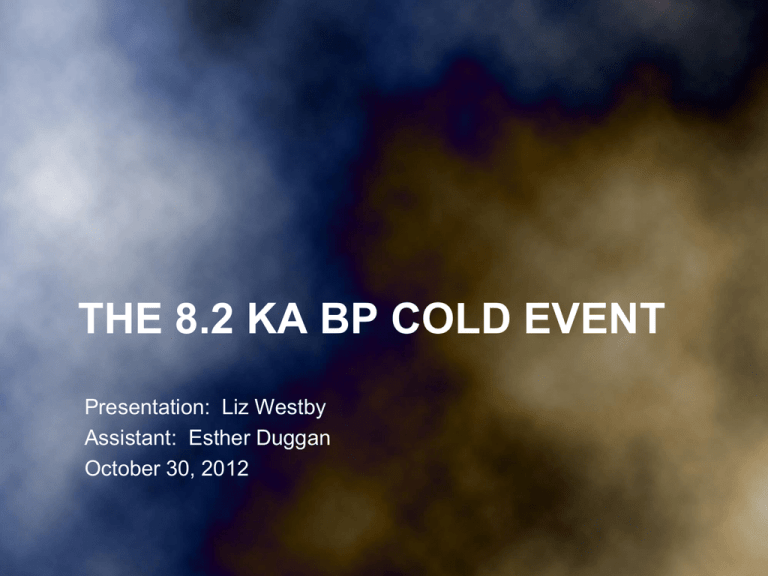
THE 8.2 KA BP COLD EVENT Presentation: Liz Westby Assistant: Esther Duggan October 30, 2012 Description GISP2 Ice Core • • Alley et al., 1997 • Identified in lacustrine sedimentary sequences in northern Sweden in 1976 (Head, 2007); found in Greenland ice core Background climate was “stable” when -– Temperature dropped by 4–8° C in central Greenland, 1.5–3°C at marine and terrestrial sites around the northeastern North Atlantic Ocean (Barber, 1999) • Snow accumulation decreased • Precipitation of chemical impurities increased, forest fires more frequent (Clarke, 2003) • The event lasted for 100-200 years (Clarke, 2003) Largest abrupt climate change in the last 10,000 years (Kobashia et al., 2007) 3 A Near-Global Event Cooling in North America, with drying in the US Great Plains European region experienced strong cooling Weakened Asian Monsoon (from speleothems of Dongge Cave, southern China) Southward shift of the ITCZ inferred from the Cariaco Basin record Alley et al., 1997 Sahara experienced drying 4 Questions to Address • Is this a synchronous event? – Evidence from ice cores • What triggered the event? – Freshwater forcing • What was the impact of the event? – THC sensitivity • Uncertainties? – Lack of uniform record Ice Core Record Ice Core Records • Local Conditions – Temperature (18O) – Snow accumulation (layer thickness) • Regional – Wind-blown sea salt (Cl-) – Continental dust (Ca2+) • Hemispheric or Global – Trapped-gas bubble records (methane) Legrand and Mayewski, 1997 7 Revisit Alley’s Figure 1 GISP2 Alley et al., 1997 • Decrease in snow accumulation • Decrease in temperature • Increase in Cl• Increase in CA2+ • Oscillating NO3• Decrease in methane • Together, cold, dry, and dusty 8 Similarities to Younger Dryas • Compare to baseline – 8 ka and 8.4 ka (8.2 ka Event) – Early Preboreal (YD) Alley et al., 1997 • Movement in same directions • Magnitudes off • YD sustained for a millennium • 8.2 ka lasts for ~150 years 9 Same Trigger as YD? Younger Dryas may have been triggered by an outburst of waters from a large icedammed lake and sustained by the redirection of meltwater from the Mississippi to the St. Lawrence Valley (Clarke, 2003) 10 Freshwater Forcing 11 Laurentide • Around 8.5 ka BP – 3 km thick dome Obbink et al., 2010 – Area of Hudson Bay to Labrador Sea (Clarke, 2003) • Disintegrating, calving into Hudson Bay (Clarke, 2003) • With northward retreat, land surface depressed, sloping north (Clarke, 2003) 12 Lake Agassiz Clarke et al., 2003 Discharge of ~0.1 Sv to St. Lawrence Valley 13 Outburst • Northward outburst 8.450 ka BP • Marine geophysical surveys support high rates of water discharge in Hudson Bay associated with one or more outburst floods – megaripple sand-wave bed forms – arcuate scours on floor of Hudson Bay (Clarke, 2003) • Hematite-rich rocks from the northern part of Hudson Bay are thought to be the source of red clay marker beds within Hudson Strait (Keigwin et al., 2005) • Oldest marine mollusk around Hudson Bay ~8.45 ka • Modern outburst analogs found in Iceland but not so big (Clarke, 2003) 14 Mechanics Clarke et al., 2003 • Water establishes a subglacial path • Conduit grows by melting, stays open as long as water pressure exceeds overburden pressure • Following an outburst, flood channel either remains open (smaller diameter) or reseals so that lake level rises until a subsequent flood is released (Clarke, 2004) 15 Discharge • Glacial Lake Agassiz-Lake Ojibway – ~163,000 km3 in volume – ~841,000 km2 in areal extent prior to the final release of lake (Leverington, 2002) • Actual discharge uncertain – Estimates from 1.2 x 1014 m3 (0.012 Sv) to 5 x 1014 m3 (0.05 Sv) – Duration of the meltwater pulse ranges from 0.5 to 500 years (Renssen, 2001) 16 Marine Cores: GGC26 • • • Increase in abundance of N. pachyderma Carbon isotope ratios of C. wuellerstorfi low enough to indicate significantly decreased NADW production at several times in the Holocene, including 8.2 ka. Not all cores show same trends Keigwin et al., 2003 17 Keigwin et al., 2003 Effect on Climate Outburst causes a slowdown of the meridional overturning circulation, which enabled wintertime sea ice cover to expand with consequent hemispheric cooling and drying, especially surrounding the North Atlantic area (Kobashia et al., 2007) 18 Response Lag Kleiven et al., 2008 • • • • Event occurs 8.4 ka but cold event peaks at 8.2 ka. Why didn’t ocean respond immediately to outburst? Outburst event longer? 500 years? Stronger flux of Atlantic water towards north – had a higher capacity to remove freshwater and replace it with more salty water? (Klitgaard-Kristensen, 1998) 19 THC Sensitivity THC • Warm surface water flows north, releases heat, sinks, and flows south as cold deep water • Volume of transport is about 17 ±4 Sv (1 Sv = 106 m3s-1) • Circulation in the North Atlantic driven by sensitive density balance between salinity, temperature and influx of freshwater http://www.lmvp.org/Waterline/winter2003/therm ohaline.htm 21 GCM Suggests Sensitivity • General circulation model (GCM) by Geophysical Fluid Dynamics Laboratory in Princeton suggest NADW circulation is highly sensitive to freshwater forcing • Some models project enhanced freshwater fluxes to North Atlantic will slow or stop deep water formation if maintained long enough • 0.015 Sv delivered to the Labrador Sea sufficient to stop convection in one model (Alley et al., 1997) • NADW circulation winds down with an input of less than 0.06 Sv into the catchment area of the North Atlantic (Rahmstorf, 1995) • May collapse if a certain threshold is exceeded and can 22 show hysteresis behavior Renssen (2001) Model Renssen, 2001 • Multiple freshwater experiments • Amount of freshwater constant at 4.67 x 1014 m3 (~0.05 Sv) • Timing of release varies • 20-year release likely trigger to 8.2 ka event 23 Wiersma (2011) Model • ECBilt-CLIO-VECODE (version 3) – 3-D climate model of intermediate complexity consisting of an atmospheric, sea-ice ocean and vegetation component with free-surface ocean general circulation model coupled to a comprehensive sea ice model with a representation of both thermodynamic and dynamic processes 24 Wiersma Results • Freshwater forcing in Labrador Sea produced a temperature anomaly over central Greenland in agreement with that observed during the 8.2 ka event • Detectable temperature response to a freshwater forcing is not synchronous, lags mostly in the order of decades – Delayed response over Greenland of 30 years – Simulation suggests a delay of more than 50 years of detectable cooling over Asia 25 Results (cont.) • Lag due to an initial decadal warming – brief westward shift of deep-water formation from just south of Svalbard to north of Iceland – brings additional heat to Greenland (Wiersma, 2011, Renssen, 2001) • Substantial increase in sea-ice coverage, with most of the Nordic Seas and the Denmark Strait becoming perennially ice covered (Renssen, 2001) • Sea-ice cover causes a considerable cooling of the lower atmosphere over the Nordic Seas and adjacent 26 landmasses (Renssen, 2001) Other Evidence • Nova Scotia Lake Deposits – Not conclusive – too short of an event/too subtle a signal? (Spooner, 2002) • Western Ireland Peat – Dryer and cooler conditions in pollen record dated to 7740 yr BP and 7220 yr BP (Head, 2007) – dating errors? • Too few high-resolution records from the Southern Hemisphere to determine whether climate changed there (NOAA) 27 Alternatives to Freshwater Flux? • Millennial-scale cooling trend started a few centuries earlier than the 8.2 ka event (Kobashia et al., 2007) • A minor solar minimum coinciding with the 8.2 ka event, forcing the system to cross a threshold, triggering the 8.2 ka event (Kobashia et al., 2007) • Or…? 28 Relevance • Freshwater fluxes of similar magnitude may occur in future – Global warming of 3°C in response to doubling atmospheric CO2 could increase total freshwater flux from Greenland ice sheet by 0.02 Sv and maintain the level over centuries (Alley et al., 1997) – Enhanced high latitude precipitation and sea ice melting in response to warming might cause an increase of similar magnitude in freshwater flux to North Atlantic (Alley et al., 1997) • Freshwater flux at the right time, right place could trigger abrupt climate change (Alley et al., 29 1997) References Alley, R.B., Mayewski, P.A., Sowers, T., Stuiver, M., Taylor K.C., Clark P.U., 1997, Holocene climate instability: A prominent, widespread event 8200 yr ago: Geology v. 25, n. 6, p. 483-486. Barber, D. C., Dyke, A., Hillaire-Marcel, C., Jennings, A. E., Andrews, J. T., Kerwin, M. W., Bilodeau, G., McNeely, R., Southon, J., Morehead, M. D., Gagnon, J. M., 1999, Forcing of the cold event of 8,200 years ago by catastrophic drainage of Laurentide lakes: Nature v. 400, p. 344–348. Clarke, G., Leverington, D. W., Teller, J. T., Dyke, A. S., 2004, Paleohydraulics of the last outburst flood from glacial Lake Agassiz and the 8200 BP cold event: Quaternary Science Reviews v. 23, p. 389–407 Clarke, G., Leverington, D., Teller, J., Dyke, A., 2003, Superlakes, Megafloods, and Abrupt Climate Change: Science v. 301, p. 922-923. Head, K., Turney, C.S.M., Pilcher, J.R., Palmer, J.G., Baillie, M.G.L., 2007, Problems with identifying the ‘8200-year cold event’ in terrestrial records of the Atlantic seaboard: a case study from Dooagh, Achil Island, Ireland: Journal of Quaternary Science v. 22, n. 1, p. 65-75. Keigwin, L. D., Sachs, J. P., Rosenthal, Y., Boyle, E. A., 2005, The 8200 year BP event in the slope water system, western subpolar North Atlantic: Paleoceanography v. 20, p. 1–14. Kleiven, H.F., Kissel, C., Laj, C., Ninnemann, U.S., Richter, T.O., Cortijo, E., 2008, Reduced North Atlantic Deep Water Coeval with the Glacial Lake Agassiz Freshwater Outburst: Science v. 319, p. 60–64. Klitgaard-Kristensen, D., Sejrup, H. P., Haflidason, H., Johnsen, S., Spurk, M., 1998, A regional 8200 cal. yr BP cooling event in northwest Europe, induced by final stages of the Laurentide ice-sheet deglaciation? Journal of Quaternary Science v. 13, p. 165–169. Kobashia, T., Severinghaus, J. P., Brook, E. J., Barnolac, J., Grachev, A. M., 2007, Precise timing and characterization of abrupt climate change 8200 years ago from air trapped in polar ice: Quaternary Science Reviews v. 26, p. 1212–1222. Legrand, M., Mayewski, P. A., 1997, Glaciochemistry of polar ice cores: A review: DigitalCommons@UMaine, available at http://digitalcommons.library.umaine.edu/cgi/viewcontent.cgi?article=1276&context=ers_facpub, accessed 10/28/2012. Leverington, D. W., Mann, J. D., Teller, J. T., 2002, Changes in the Bathymetry and Volume of Glacial Lake Agassiz between 9200 and 7700 14C yr B.P.: Quaternary Research v. 57, p. 244–252. NOAA National Climatic Data Center, 2008, Post-glacial cooling 8,200 Years Ago, available at http://www.ncdc.noaa.gov/paleo/abrupt/data5.html, accessed 10/27/2012. Rahmstorf, S., 1995, Bifurcations of the Atlantic thermohaline circulation in response to changes in the hydrological cycle: Nature v. 378, p. 145–149. Renssen, H., Goosse, H., Fichefet, T., Campin, J.M., 2001, The 8.2 kyr BP event simulated by a global atmosphere-sea-ice-ocean model: Geophysical Research Letters, v. 28, n. 8, p. 1567-1570. Spooner, I., Douglas, M.S.V., Terrusi, L., 2002, Multiproxy evidence of an early Holocene (8.2 kyr) climate oscillation in central Nova Scotia, Canada: Journal 30 of Quaternary Science v. 7, n. 17, p. 639-645.





